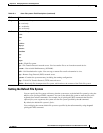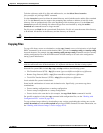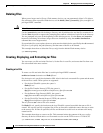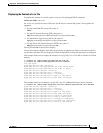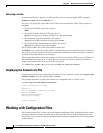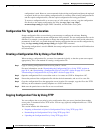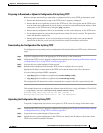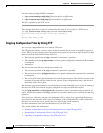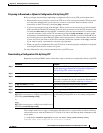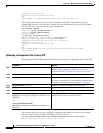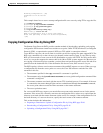
20-8
Cisco IOS Software Configuration Guide for Cisco Aironet Access Points
OL-30644-01
Chapter 20 Managing Firmware and Configurations
Working with Configuration Files
Extracting a tar File
To extract a tar file into a directory on the Flash file system, use this privileged EXEC command:
archive tar /xtract source-url flash:/file-url
For source-url, specify the source URL alias for the local or network file system. These options are
supported:
• For the local Flash file system, the syntax is
flash:
• For the File Transfer Protocol (FTP), the syntax is
ftp:[[//username[:password]@location]/directory]/tar-filename.tar
• For the Remote Copy Protocol (RCP), the syntax is
rcp:[[//username@location]/directory]/tar-filename.tar
• For the Trivial File Transfer Protocol (TFTP), the syntax is
tftp:[[//location]/directory]/tar-filename.tar
The tar-filename.tar is the tar file from which to extract files.
For flash:/file-url, specify the location on the local Flash file system into which the tar file is extracted.
You can also specify an optional list of files or directories within the tar file for extraction. If none are
specified, all files and directories are extracted.
This example shows how to extract the contents of a tar file located on the TFTP server at 172.20.10.30.
This command extracts just the new-configs directory into the root directory on the local Flash file
system. The remaining files in the saved.tar file are ignored.
ap# archive tar /xtract tftp://172.20.10.30/saved.tar flash:/new-configs
Displaying the Contents of a File
To display the contents of any readable file, including a file on a remote file system, use the more [/ascii
| /binary | /ebcdic] file-url privileged EXEC command:
This example shows how to display the contents of a configuration file on a TFTP server:
ap# more tftp://serverA/hampton/savedconfig
!
! Saved configuration on server
!
version 11.3
service timestamps log datetime localtime
service linenumber
service udp-small-servers
service pt-vty-logging
!
<output truncated>
Working with Configuration Files
This section describes how to create, load, and maintain configuration files. Configuration files contain
commands entered to customize the function of the Cisco IOS software. To better benefit from these
instructions, your access point contains a minimal default running configuration for interacting with the
system software.






